We've conducted extensive testing of various window cleaning devices to find out how effective both manual and robotic window cleaners are. Seasonal window renewal is just around the corner, so if you are thinking about buying an electronic assistant to maintain crystal cleanliness, be sure to study our analytical review.
Manual window cleaners, or battery-powered windshield wipers
On the market you can find devices called “window vacuum cleaners”. However, they actually work on the principle of vacuum suction of soaked dirt and removal of residue using a silicone scraper. These washers usually come with a detergent spray bottle, a microfiber pad, and the detergent itself. The idea was first presented by the Karcher company, but later it was picked up by other manufacturers. Chinese analogues have also appeared, but branded products offer more reliable service and quality. For example, the Karcher WV 7 Signature Line cordless windshield wiper offers an improved coupler and additional features to make it easier to use.

Advantages of a manual washer over a robot for washing windows
- Vacuum cleaning of glass guarantees the cleanliness of the space, eliminating the splashing of drops, and during normal operation the washer does not leave streaks.
- The washer is able to wash all smooth surfaces at any angle, including areas near frames. This makes it convenient to use even in hard-to-reach places where the user himself washes.
- In the event of a power outage or battery discharge, the washer will not fall from the surface and will not damage surrounding objects.
- Manual control is more effective, as it allows you to direct efforts where they are really needed.
- Most manual battery windshield wipers are available at a lower price compared to robotic ones.
Cons of battery-powered windshield wipers
- Working outside, especially on large windows, is difficult or even impossible due to their size.
- The weight of the washers is quite significant, as it includes a body with a motor and a liquid reservoir, which makes them quite heavy.
- It is necessary to monitor the battery charge level, since if it is depleted, you will have to clean the window manually.
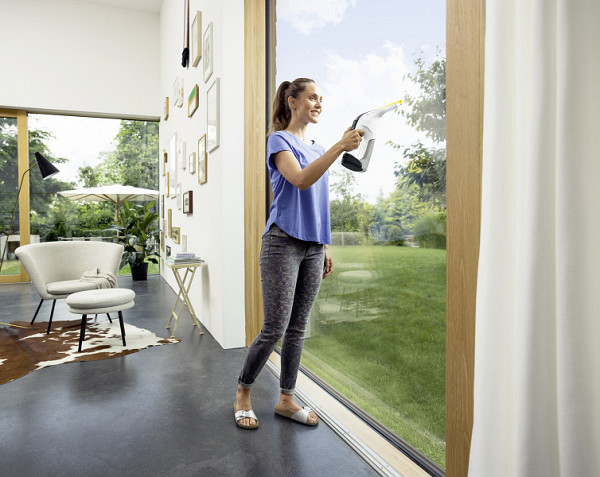
What to look for when choosing a manual window cleaner?
- Battery life is also important to consider. For example, the top-end Karcher model works up to 100 minutes without recharging, but most washers on the market can work two to three times less time.
- It is also worth considering whether the scraper is removable. The removable scraper can be easily cleaned or replaced if damaged or worn.
- It is also important to pay attention to the equipment. The presence of nozzles with soft mops makes the washing process easier, and the presence of an extension stick allows you to reach high-positioned glass.
- When choosing, you should also take into account the availability of consumables on sale.
Window cleaning robots
Window cleaning robots have been developed as devices that can automatically carry out the glass cleaning process, especially in areas where a human cannot reach or where a manual cleaner is difficult to use. They are necessary for cleaning windows with panoramic glazing, working on high floors and processing the outside of windows. The main advantage of robots is their ability to reach hard-to-reach places.
Window cleaning robots can have different designs: square or elongated with two rotating cleaning mops. The first type of design is less common, but provides better elaboration of corners.
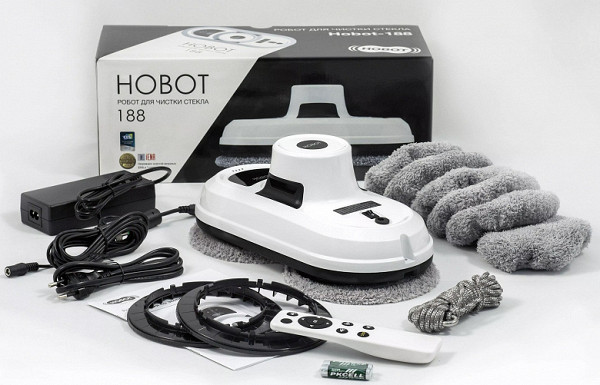
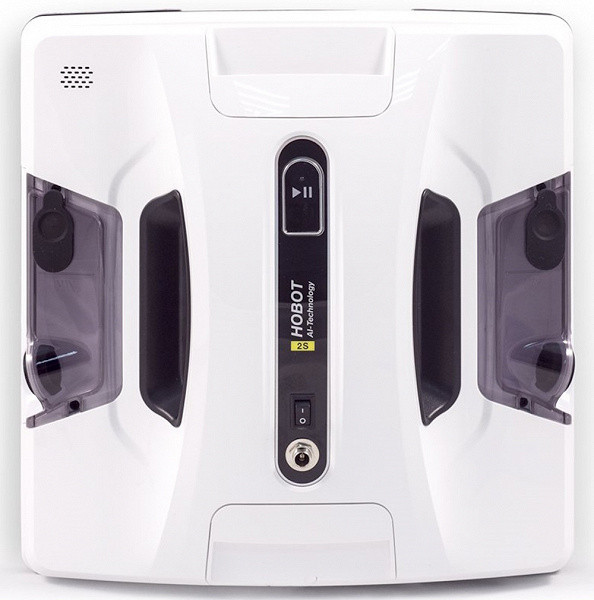
Window cleaning robots are held on the surface by thin air. They carry out the cleaning process by spraying a cleaning solution onto surfaces, wiping them with microfiber cloths or mops, and sucking up any remaining dirt and liquid. Some models offer two operating modes — dry and wet cleaning, where dry cleaning serves as preliminary surface preparation. Robots are usually equipped with edge or corner sensors that detect window edges or obstacles.
Robots are usually controlled in three ways: through buttons on the body, a remote control or a mobile application.
Advantages of robots over battery-powered windshield wipers
- Most robots are powered by electricity, which allows them to operate without time restrictions. However, in the event of a power failure, the robot can stay on the surface with the help of a battery for 30 to 45 minutes, depending on the model.
- The robots are capable of handling large and high surfaces, including the outside of windows. Their range can exceed five meters from the outlet.
- The user does not require physical effort while the robot is operating, with the exception of assistance in overcoming obstacles, replacing napkins and refilling with cleaning solution. Caring for the device includes pouring out water, washing mops, and the like.
Cons of robots
- The robotic windshield wipers we've tested don't always clear heavy dirt the first time. Sometimes a repeat or even a third run is required because mops and wipes cannot completely remove old dirt, especially splashes or insects. Before starting the robot, it is recommended to wipe the window with a damp sponge and detergent or spray detergent on the glass.
- Robots are unable to overcome obstacles such as frames or thick frames, so the device must be moved from one surface to another manually. At the moment, robots do not have the ability to automatically jump over obstacles.
What to look for when choosing a robot?
When choosing a robotic windshield wiper, it is important to consider the following aspects:
- Purpose: to determine for which surfaces and types of glazing the robot is suitable, taking into account the minimum glass thickness. It is also important to find out whether the robot is capable of working on angled surfaces, such as roof windows.
- Overcoming obstacles: evaluate what obstacles the robot can overcome, such as frames or thick edges.
- Operating range: set the maximum distance from the socket at which the robot can operate.
- Retention time on the surface: estimate how long the robot can stay on the glass without additional recharging.
- Mode for heavily soiled windows: find out if the model has a mode designed to clean heavily soiled surfaces.
- Reliability of the safety structure: it is recommended to study in person and read reviews about the reliability of the safety structure.
- Availability of consumables and their cost: check the availability of consumables for the selected model and estimate their cost.
Let's look at a few models that have been tested.
Square window cleaning robot Kitfort KT-5104
Square robotic windshield wipers are rare on the market, but their shape makes them highly effective at cleaning corners and along frames. This makes them especially suitable for working with frameless glazing and inclined surfaces, such as roof windows. At the same time, to ensure safe operation in such conditions, it is important to provide reliable insurance for the device.
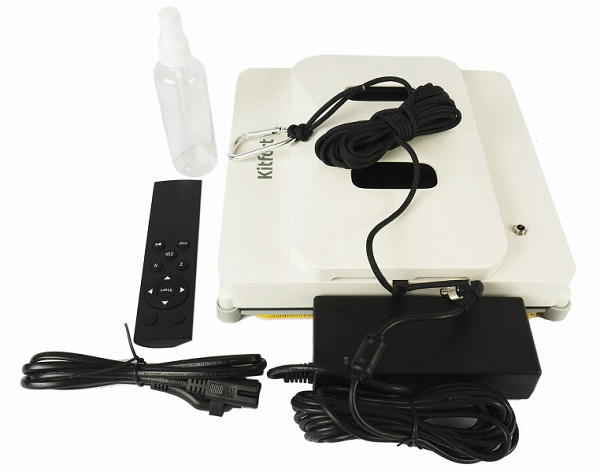
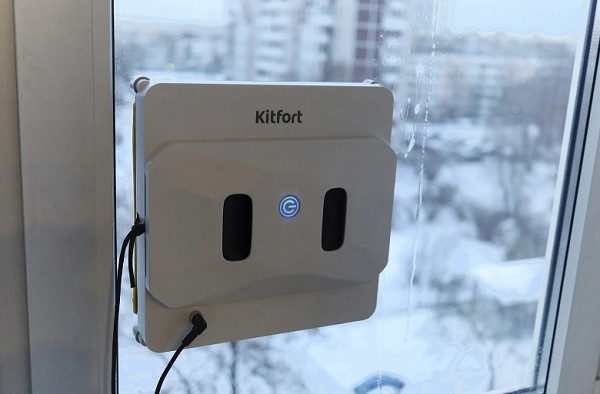
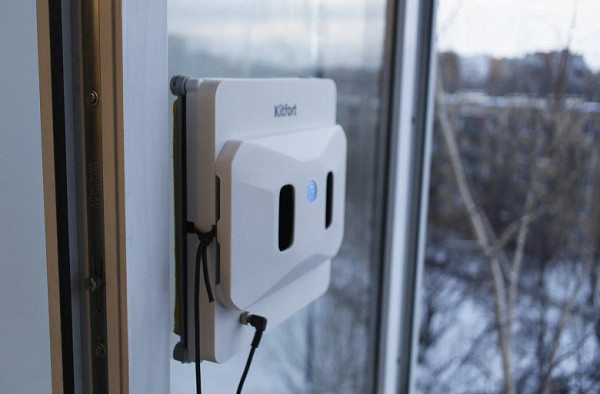
In models of this type, unlike rotary ones, the cleaning wipes are fixed, and the glass is cleaned due to the movement of the robot itself. The device is held on a vertical or inclined surface thanks to a vacuum pump that creates a vacuum of air, while its movement along the glass is carried out using rubber “caterpillar” belts with rollers inside. Two motors are responsible for moving the robot, allowing it to turn and turn around in place. The kit includes four microfiber cleaning cloths and detergent, but other glass cleaners can also be used.
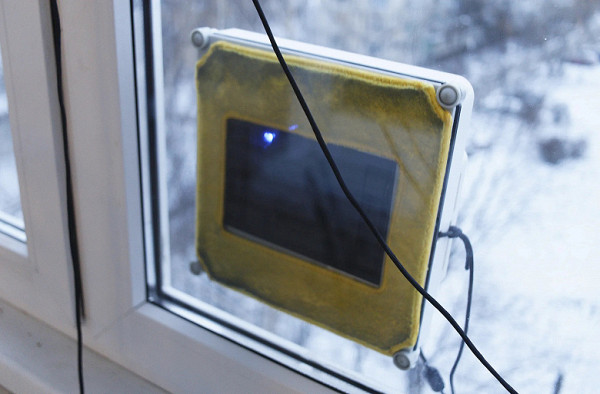
Controlling the robotic cleaner turned out to be very intuitive: there is only one button on its body, and additional commands can be set via the remote control, selecting movement algorithms or directing the device to a specific area for cleaning.
Our tests confirmed the specifications stated by the manufacturer: the robot is not equipped with a function for working with particularly dirty surfaces, which manifested itself in the inability to cope with stagnant dirt the first time. Restart required. However, it is ideal for daily glass cleaning, showing particularly good results in corners and along frames, where its efficiency is higher than that of rotary models. After his work, the windows became noticeably cleaner, and the robot did not slip or fall. We also tested it on wardrobe mirrors: it made quick work of removing fingerprints, but needed help moving to the next mirror due to its inability to step over the aluminum extrusion, leaving us to finish the area underneath by hand. The test on tiles was also a success: the robot easily cleaned different types of tiles, moving from one to another without leaving streaks.
Robot windshield wiper with rotating mops Red Solution SkyWiper RV-RW001S
This high-quality robot washer, although an expensive model, is a universal solution for cleaning double glazing, tiled surfaces, large mirrors in the interior with a minimum thickness of 3 mm, and can also be used for washing floors and individual furniture elements. The device operates by connecting to the mains, and the built-in battery can maintain operation on the surface being cleaned for up to 40 minutes after the power supply is turned off. It is based on artificial intelligence technology, thanks to which the robot effectively cleans at high altitudes and in places that are difficult to access. According to our observations, SkyWiper RV-RW001S does an excellent job of cleaning glass and is especially recommended for use in cases where it is necessary to clean large surfaces or wash windows from the outside and in places that are difficult to reach. As mentioned, it may not be effective at removing stubborn stains on the first try.
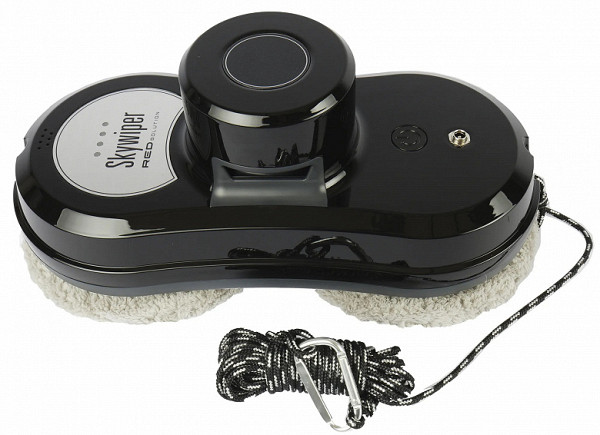
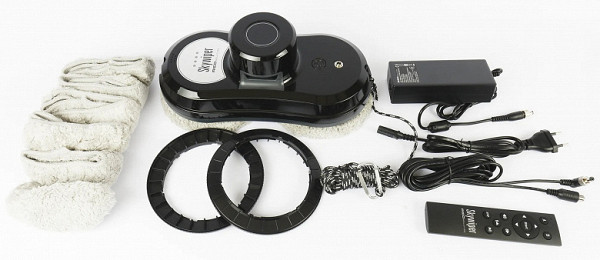
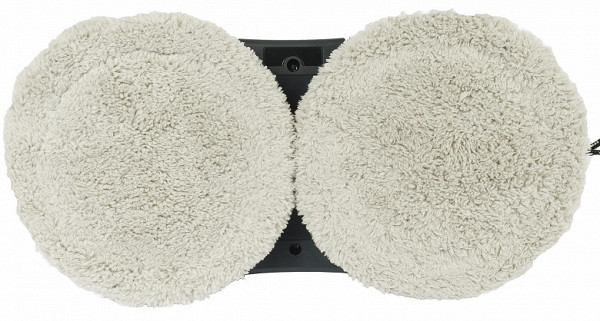
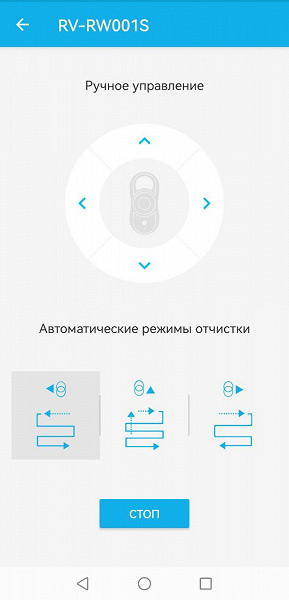
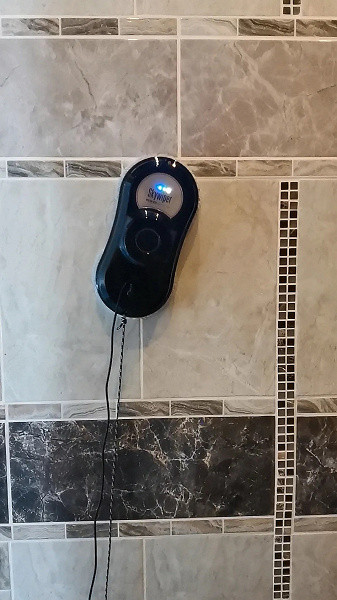
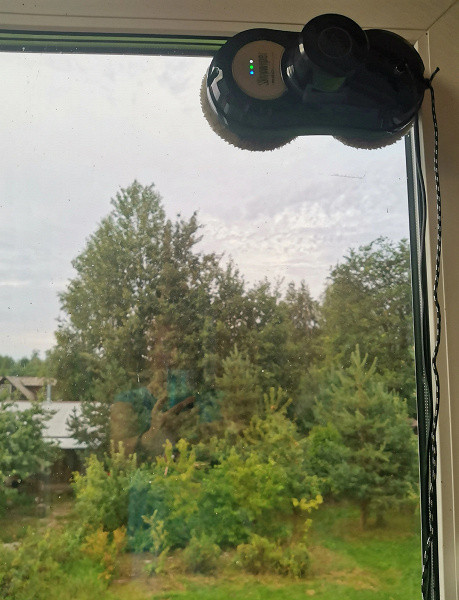
This robot performed best when working on large surfaces: the wider the area, the more efficiently it copes with the cleaning task. However, when the appliance encounters obstacles in its path, such as switches, hooks, shelves or hangers, such as when cleaning a tiled wall, its behavior becomes less predictable. The use of artificial intelligence and remote control, characteristic of this model, does not always help in such situations.
Garlyn Maxclean's not-quite-square robot
This robot is a device of a unique, almost square shape, mounted on glass using a suction cup. The model’s arsenal includes several cleaning programs designed for various tasks: from cleaning high-altitude vertical surfaces to processing wide horizontal areas, including a specialized mode for additional cleaning of contaminated areas and vertical washing, with activation of each program through the corresponding button on the body.
During testing, the robot demonstrated efficient movement across glass and high cleaning quality. However, it was noticed that the device systematically ignored the same area, which eventually became its “blind spot.” Similar to experience with other similar devices, it turned out that the robot is not intended for initial cleaning of heavily soiled glass: removing significant dirt must be done manually. Thus, for windows that are dirty after construction or a long winter, the robot will only spread the dirt and not remove it. The device copes successfully with surfaces that are less contaminated, cleaning a square meter of glass in less than five minutes.

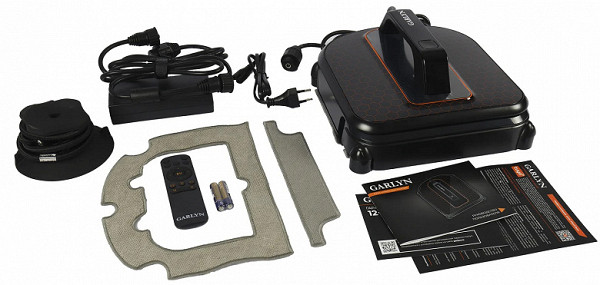
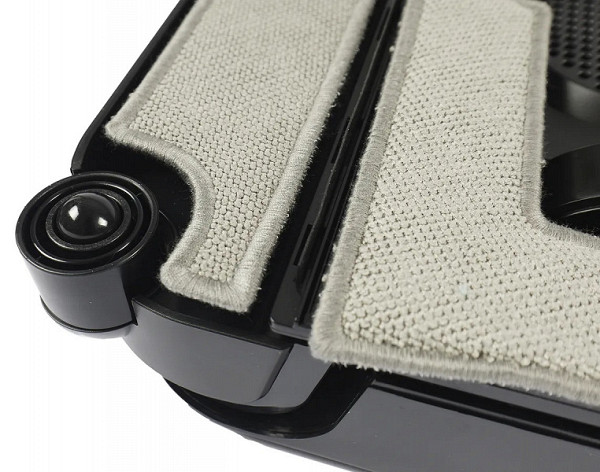
But there is an objectively strong side: the safety suction cup reliably keeps the robot from falling, and the battery power is enough to hold the device on the window for 30 minutes.
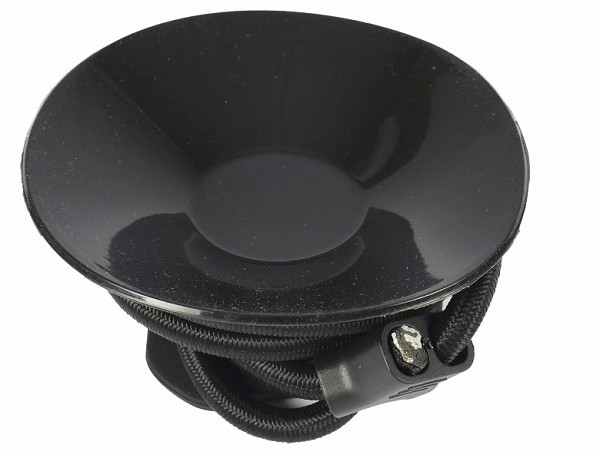
Cordless windshield wiper Redmond Window Cleaner RV-W003

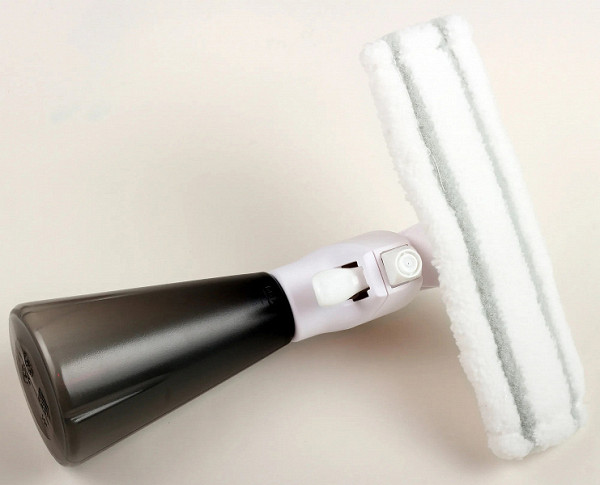

The wiper is equipped with a Micro-USB port for recharging; fully charging the battery takes 2 hours 40 minutes, which provides up to 25 minutes of operation without connecting to the network. This device is suitable for cleaning glass with a thickness of 3 mm, mirrors, tiles, smooth walls and countertops. Within the specified 25 minutes we were able to completely clean a loggia with six 70x60 cm windows, one small 70x80 cm window, a standard glazed balcony door and two large mirrors. Pollution on the loggia was more significant than in other tested places that were located indoors. As with robots, the windshield wiper was not able to completely remove intense street pollution without first cleaning it. When using the device, the mop had to be regularly moistened and rinsed under running water to avoid streaks. Dirty water mixed with detergent was successfully removed by the device without leaving any splashes on the floor or window sills. To remove heavy stains, the use of paper towels and special cleaning products was required, while cleaning was done by hand.


The bottom line is that robotic cleaners are effective for cleaning large areas that are regularly kept clean. They are ideal for servicing a large number of windows, reducing the physical labor of cleaning them. For a small number of windows that are cleaned only a few times a year, using a robot may not be justified due to the need for repeated applications to achieve perfect cleanliness.
As for battery-powered windshield wipers, their effectiveness largely depends on the personal approach and efforts of the user: how carefully he will work with the device and how well he will treat the surface. Like robots, removing particularly stubborn stains requires preliminary manual cleaning. The purchasing decision is up to the consumer, taking these nuances into account.
